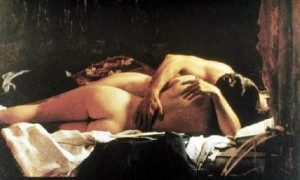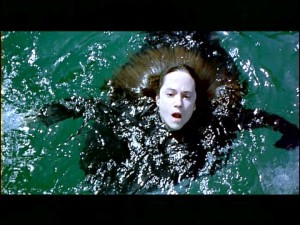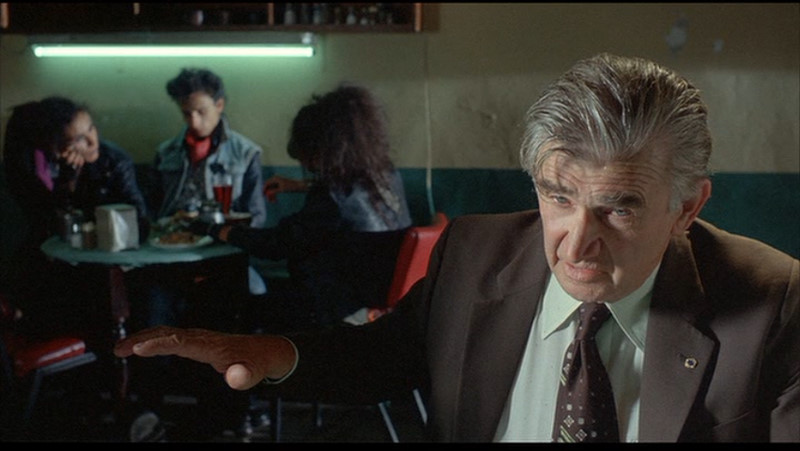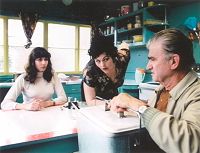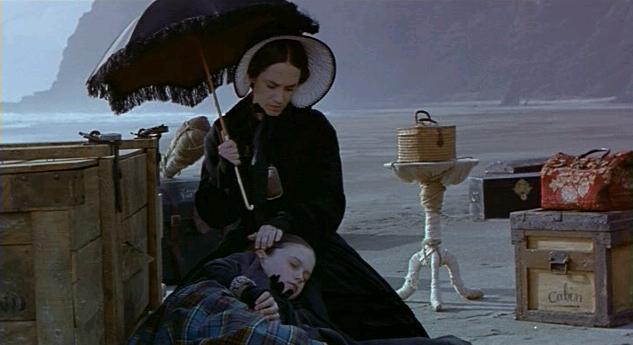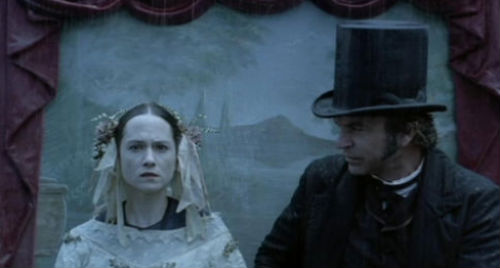From the Chicago Reader (December 10, 1993). — J.R.
THE PIANO
*** (A must-see)
Directed and written by Jane Campion
With Holly Hunter, Harvey Keitel, Sam Neill, Anna Paquin, Kerry Walker, Genevieve Lemon, Tungia Baker, and Ian Mune.
Given how sexy and volatile it is, it’s no surprise that The Piano is a hit. It’s also no surprise, given the strong-arm tactics of the distributor and the hype of some reviewers, that a certain critical backlash is already setting in, as evidenced by a lucid and considered dissent by Stuart Klawans in the Nation and a rather lazy dismissal by Stanley Kauffmann in the New Republic. People like myself who are passionate fans of Jane Campion’s previous work may be somewhat churlish that many other people are finding their way to her work only after it has become juiced up, simplified, and mainstreamed — like the people who bypassed the dreamy finesse of Eraserhead on their way to the relative crudeness of Blue Velvet. It’s certainly regrettable that viewers who weren’t interested in seeing Campion’s 1989 film Sweetie until after they saw The Piano now have to contend with a lousy video transfer that doesn’t begin to do justice to Campion’s colors and compositions. (Wouldn’t this be a good time to strike off some new 35-millimeter prints of Sweetie for a rerelease? And I, for one, would love to get a chance to see Campion’s 1986 TV feature, Two Friends, which has never been available here in any form.)
Technically speaking, The Piano is Campion’s second feature; An Angel at My Table (1990) was a three-part TV miniseries that was shown theatrically only after it won several prizes at film festivals. The distinction seems important because the relatively conventional and naturalistic style of the miniseries, in terms of acting as well as filmmaking, was clearly designed for the small screen (as was After Hours, a half-hour short about sexual harassment she made in 1991), and blowing it up deprived it of some of its intimacy. The film also suffered in temporal terms: it presents the early life of New Zealand writer Janet Frame in three separate stages, with three separate actresses playing her, and was designed to be seen on separate occasions, with time for reflection in between. (The same episodic design can be found in Krzysztof Kieslowski’s Decalogue — still, scandalously, unseen here apart from a few festivals.)
Both of Campion’s theatrical features are bold expressionist works about female sexual desire that make free and idiosyncratic use of central metaphors — though here their similarities end, and it will be interesting to see whether Campion’s next feature, an adaptation of Henry James’s A Portrait of a Lady, bears any relationship at all to this pattern. In Sweetie, the principal drama is between two antagonistic sisters — one of them sexually repressed and neurotic, the other completely uninhibited and psychotic — and the central metaphor is trees. Though a couple of trees actually figure in the plot, Campion mainly uses trees as a poetic organizing image in the consciousness of Kay, the neurotic sister, who narrates the film: she gets us to think about family trees, planted and uprooted lives, unseen depths and giddy elevations, blooming versus dying, and various forms of encroachments and entanglements.
The Piano has a narrator as well, but only at the very beginning and the very end of the picture, and the voice in this case is the inner consciousness of the mute heroine. Ada (Holly Hunter), a 19th-century Scottish woman with a little girl named Flora (Anna Paquin), informs us at the outset that she hasn’t spoken since the age of six — though, she adds, she doesn’t consider herself silent because she’s able to express herself through her piano playing. We quickly discover that Flora — with whom she converses in sign language (which is often subtitled) and who serves as her main instrument of communicating with others — is the only one she readily communicates with.
The reason for her muteness is something we never find out, and that’s the first of the film’s many structuring absences; another is the identity of Flora’s father. Though some reviewers have been calling Ada a widow, the little I can surmise is that the marriage her father (never seen) arranges for her at the beginning of the film to Stewart (Sam Neill), an English settler in the wilds of New Zealand, is her first. She and Flora are shipped off from Europe, and when they arrive with their belongings, on a beach thunderous with waves, Ada’s crated piano gets left behind at Stewart’s insistence, despite her protests. Not long after their arrival, Flora spins an elaborate yarn for Stewart’s Aunt Morag (Kerry Walker) about her parents: how they met (“in Austria, where he conducted the Royal Orchestra”), where they were married (in a forest with fairies and elves, which she then revises into a country church near the Alps), and how Ada lost her voice (a bolt of lightning struck Flora’s father and burned him to a crisp when he and Ada were singing in the mountains; this jazzy demise is illustrated by a quick patch of animation — one of many striking images in the film omitted in the published version of the script).
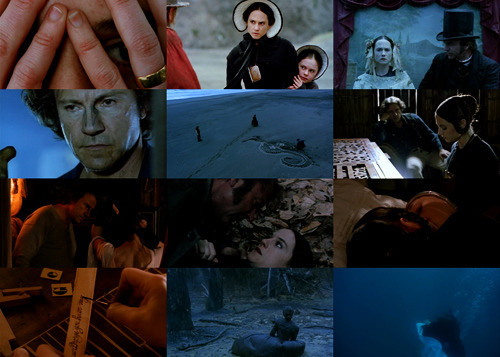
Much later, however, a scene between mother and daughter informs us that Flora was fathered by Ada’s teacher (presumably music teacher), whom Ada communicated with telepathically: “I didn’t need to speak; I could lay thoughts out in his mind like they were a sheet,” read the subtitles. But they didn’t get married because “after a while he became frightened and he stopped listening,” and after Flora was born “he was sent away.” The conclusion of Ada’s “explanation” — “I think he’s looking for us now all across the world, across the red sea” — sounds about as mythological as the elves, fairies, and lightning bolt in Flora’s account.
In short, we wind up learning as little about Flora’s father — apart from the fact that he may have been connected to Ada’s music — as we learn about the cause of her muteness. One reason for this, I think, is that a mythology of origins — the origins of New Zealand as well as the origins of female self-expression and self-realization, both personal origins of Campion herself — is at the roots of The Piano, which she has been working on since 1984. Within this mythology, Ada’s muteness and her piano are closely interrelated metaphors — and metaphors for irreducible givens, not for subjects designed to be analyzed. In 19th-century New Zealand, where female self-expression, like civilization, is postulated as still being on the brink of formation, Ada’s muteness is set forth as a kind of inexact metaphor for the repression of women–an oddity and an encumbrance, like her enormous hoopskirts, but still a fact of life. Her piano, which signifies civilized speech, is a personal necessity to Ada but only an oddity and an encumbrance to Stewart (which is why he orders it left behind). Completing this awkward schema are the Maori natives, a chattering Greek chorus of noble and enlightened primitives, and Baines (Harvey Keitel) — an American settler and a neighbor of Stewart’s, who has “gone native” by getting himself tattooed and learning the local Maori lingo. There are also a few other white locals, such as the reverend and his sister Nessie (the latter played by Genevieve Lemon, the actress who played Sweetie).
Unlike the half dozen or so major figures in Sweetie, none of the participants in The Piano qualify as characters in the round, with an implied reality beyond the frame of Campion’s story; for all the power of the three central performances, they’re merely vehicles for a series of jolting effects and escalating climaxes, providing at best annexes to the central metaphors. (In some ways Stewart can be read as inhibited and voyeuristic Europe, Baines as action-hero America with a trace of Mr. Natural. It’s tempting to read even Campion’s projected professional future into the fate of Ada, with Stewart as the European art movie and Baines as Hollywood.) When Stewart tells Baines quite late in the film that he’s achieved telepathic communication with Ada, presumably as Flora’s father once did, and then recites a message from her verbatim, this comes across not as any sort of character development but as a contrived narrative device.
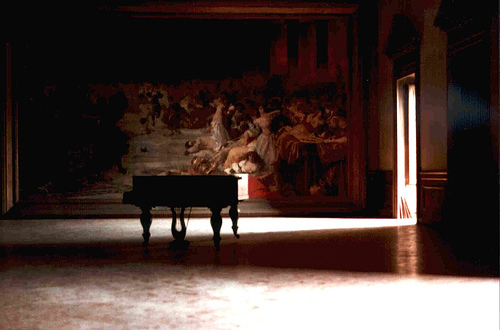
Near the beginning of the story, Baines buys the piano from Stewart (who assumes ownership rights over Ada’s property immediately upon her arrival). Baines, who values the piano because he associates it with Ada and values Ada because he associates her with sex, has it transported from the beach to his hut, and then strikes a deal with Ada–he’ll swap piano lessons for the piano itself. In fact, these “lessons” consist of erotic favors Ada hesitantly dispenses at Baines’s request: letting him crawl under her skirts, finger the hole in her stocking, and ultimately get them both to strip. It’s a barter arrangement that parallels Stewart’s attempted deals with the natives (at one point he absurdly offers buttons in exchange for land), but it’s much more successful: by the end of the lessons, it has transformed Ada from a repressed being to a fully sexual one.
Their arrangement also bears an unsettling relationship to the deal between cannibalistic serial killer Hannibal Lecter and FBI agent Clarice Starling in The Silence of the Lambs, whereby she dispenses intimate revelations about herself in exchange for his insights into the minds of serial killers. In both cases, the intimations of rape and prostitution are overriden (or, more precisely, justified) by the notion of consent; and both The Silence of the Lambs and The Piano have been celebrated in some quarters — though not generally the same quarters — as both feminist and erotic: politically correct porn.

The position Ada puts herself in also bears some relation to arguments about Madonna “being in control of her own image” — unlike, say, Marilyn Monroe, who comprises part of the image Madonna allegedly controls — and strikes me as being about equally questionable. This isn’t to say that men and women shouldn’t be allowed to entertain and enjoy sexual fantasies. (Personally I get plenty of kicks out of Campion’s film, a stray few out of Madonna’s music videos, and none at all out of the Silence of the Lambs tango.) But squaring such kicks with an idealist political agenda is difficult — especially if you’re going to sweep the issue of male coercion hurriedly under the carpet; the barter arrangements in both The Silence of the Lambs and The Piano are proposed and launched by the men, and the women’s initial response to them are recoil and resistance. And when Ada’s libido finally runs free of male coercion toward the end of the picture Campion seems far from endorsing the consequences. (It’s clear, for one thing, that Ada’s independence hurts her relationship with Flora, and before long she’s ready to chuck the piano and herself, too.)
To Campion’s credit, one can’t say that the erotic power and political agenda of The Piano are simply unrelated or without mutual relevance — even if her references in interviews to the romanticism of Wuthering Heights tend to muddy the waters on this matter. (Arguably this movie comes closer to the neoprimitivism of D.H. Lawrence than to the gothic romanticism of Emily Bronte.) After Baines ends the “piano lessons” (“I’m giving the piano back to you. The arrangement is making you a whore and me wretched”), she applies what she’s learned to her marriage, treating Stewart as a sex object — someone to be touched and caressed who is not supposed to return any caresses. From here on, the fury of Ada’s will matches the fury of Campion’s will as filmmaker, for better and for worse; it’s exciting to watch, but calculated to overwhelm rather than stimulate thought, so that when Ada is finally learning to speak at the end, you aren’t really prepared to listen; you’re more inclined to sigh with exhausted relief that the picture’s finally over.
The metaphorical transformations of speech into music and music into sex — like the literal transformations of both sign language and Maori into English speech and subtitles — only clarify the extent to which this is really a film about discourse, including film language itself. When the camera caresses the naked back of Baines as he polishes the piano in his hut, it seems to “polish” him as well; Baines getting under Ada’s skirts is roughly equivalent to the camera getting under the boat carrying her piano. When Ada strokes Stewart’s body, she seems to be playing him like a piano, and at the film’s gruesome climax, even fingers and piano keys — both displaced phallic images — start to become interchangeable. In the course of reminding us that sex is a form of discourse, the film also reminds us that all forms of discourse have political implications. Just what those implications are is still open to debate.

